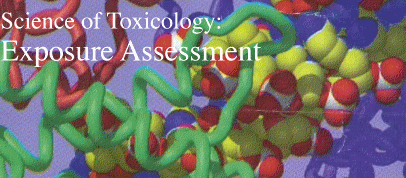DETERMINING EXPOSURE There are two general types of exposure scenarios--chronic and acute. Chronic or ongoing (or typically continuing for at least three months) means it is usually possible to measure actual exposure, in terms of amounts one comes in contact with. Determining length of exposure, which factors into overall exposure, is more complex since it depends on memory or other records and the accuracy of those. Chronic exposure is typically seen in water pollution or air pollution from an industrial plant or in a work place. It can also take place near a hazardous waste site or refer to the pollutants emitted by cars, which although fluctuating from day to day, remain relatively stable. Individuals can wear personal monitors to measure exposure or, in the case of industrial emissions, monitors can be set up around the plant to measure emissions. Exposure can also be measured or estimated by various markers in tissues, in the blood or in the urine. These can include the parent compound, such as lead, mercury, cadmium, or metabolites of those compounds, such as is the case with pesticides. Markers can also include other compounds that form due to exposure to a chemical, such as carboxymethemoglobin in the case of carbon monoxide exposure or methemoglobin in the case of exposure to nitrites. The chemicals combine with hemoglobin, the oxygen carrying compound, preventing it from being carried and causing potential brain damage and death. But these markers, while indicating exposure and whether it's mild or severe, cannot determine it precisely. Acute exposure is usually a one time or few times event that is also usually unexpected. Determination of exposure is almost always after the fact. With the exception of the rare times when something remains that allows accurate measurement of exposure, direct measurement is not possible. Instead, a surrogate of exposure is required. This means a substitute that is known, based on past experience, to accurately represent exposure. But because this is taking place after the fact, it can typically only indicate general gradations of exposure--mild, moderate and severe. A common surrogate of exposure is distance downwind (or downstream) from a chemical release; the farther the distance, the lesser the exposure (this is not always true). Other surrogates of exposure include time spent in high exposure area (at work, at home, near hazardous waste site), consumption of water, or food type or soil (young children), all of which are estimates and necessarily subjective. |
||||


Risk Assessment is another type of causation: predicting whether an exposure, usually in a population rather than a single individual, will increase the risk of developing some adverse health effect, without necessarily determining whether such health effect actually occurs. Risk means that all such exposed individuals are more likely to develop an adverse effect, but it does not mean that any particular individual will or even that the majority of individuals will. Smoking, for example, increases risk of lung cancer from approximately one in 100 to 1 in 10--a significant increase. Nevertheless, ninety percent of smokers do not develop lung cancer, even though they are all at increased risk. Risk Assessment is used by regulatory agencies, such as the EPA, to determine how much of a chemical can be released into the environment without causing an unacceptable increase in risk of an adverse effect. 'Unacceptable' is more of a policy decision than a scientific one.
Specific causation analysis can be divided into the following three components:
(1) Hazard Assessment
(2) Exposure Assessment
(3) Health Assessment
(1) Hazard Assessment: what harm can the chemical cause, based on intrinsic toxicity and circumstances of exposure, form of chemical (gas, liquid, solid) and susceptibility of individual.
(2) Exposure Assessment how much of the chemical is in a media (air, water, food, soil) available to be taken into the body? Is this a one-time or multiple exposure? Does it occur over a short period of time (acute) or over many months or years (chronic)? How does the length of exposure affect the toxicity of the chemical? How much of the chemical gets absorbed into the body (dose), and where in the body does it end up (distribution and target organ/tissue)?
(3) Health Assessment: what type of health effect develops (or gets exacerbated), and does this occur immediately or after a delay (lag time)? Is this a new effect in the individual or is there a history of this type of problem, made worse by the chemical exposure? Is the individual in a high risk group (in utero, infant, elderly, reduced immune function)? Are there other (alternative) known causes for this problem and were these causes present ?
EXPOSURE VERSUS DOSE:
What is the difference?
- Exposure: that which one comes in contact with, through the air, water, food, soil.
- Dose: that which gets into the body or in contact with it (skin or eye exposure).
- Dose can be further broken down into:
That which gets into the blood stream (circulating dose)
That which gets into cells or organs (target dose)
Why do these distinctions matter?
- Amount of exposure does not necessarily produce an equivalent dose (two people exposed to the same air pollutant will receive very different doses if one is resting and the other is exercising and breathing very heavily; of if one individual is breathing through his nose and the other has a cold and is mouth breathing.
- Amount of circulating dose does not necessarily produce an equivalent target dose in a tissue, cell or organ
Can dose be determined from most exposures?
- No! Although 'dose makes the poison' is a fundamental tenet of toxicology, it is very hard if not impossible to actually measure dose except in well-controlled lab or clinical experiments (i.e., when someone is given a shot or carefully measured amount of a drug to take).
Exposure Assessment